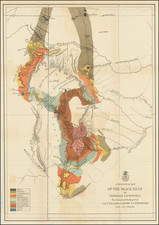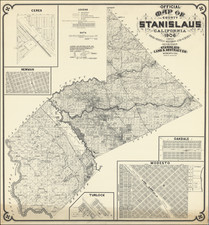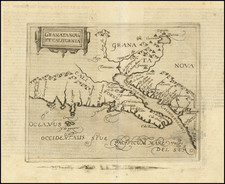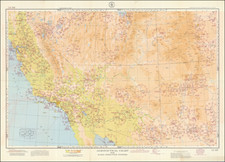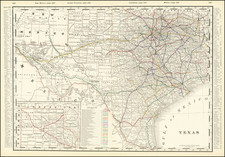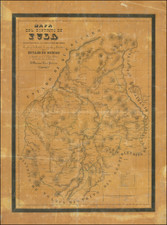Nice example of the Northwestern sheet from Arrowsmith's seminal map of Mexico, covering California, Nevada, Arizona, Utah, New Mexico and parts of Colorado, Baja California and Sonora.
The map includes Lake Timpanogos in Utah (Salt Lake), partial depictions of the rivers flowing east from San Francisco and Monterey, and the tracks of Vancouver's voyage in 1792.
The California Missions are noted, with the rivers flowing westward from the Rocky Mountains well-illustrated for the period.
Arrowsmith's map was the first to report the discoveries of Pike and Humboldt, having been issued prior to the official accounts of these two explorers. While the map draws from the work of Humboldt extensively (and Humboldt accused Arrowsmith of plagerism), the map shows substantial improvements over the Humboldt map in several areas. Arrowsmith drew on Vancouver's charts for his treatment of the California Coastline, Pike's accounts for the mapping of Texas and the Brazos and Guadalupe River regions and other rivers explored by Pike, and Humboldt's treatment of the Rocky Mountain regions and the Gulf Coast.
Arrowsmith's map of Mexico has widely gained acceptance as the most influential of all regional maps from this time period, a landmark in the Cartographic History of Texas and the Southwest, and a cornerstone map in American Cartographic History.
The Arrowsmiths were a cartographic dynasty which operated from the late-eighteenth century to the mid-nineteenth. The family business was founded by Aaron Arrowsmith (1750-1823), who was renowned for carefully prepared and meticulously updated maps, globes, and charts. He created many maps that covered multiple sheets and which were massive in total size. His spare yet exacting style was recognized around the world and mapmakers from other countries, especially the young country of the United States, sought his maps and charts as exemplars for their own work.
Aaron Arrowsmith was born in County Durham in 1750. He came to London for work around 1770, where he found employment as a surveyor for the city’s mapmakers. By 1790, he had set up his own shop which specialized in general charts. Arrowsmith had five premises in his career, most of which were located on or near Soho Square, a neighborhood the led him to rub shoulders with the likes of Joseph Banks, the naturalist, and Matthew Flinders, the hydrographer.
Through his business ties and employment at the Hydrographic Office, Arrowsmith made other important relationships with Alexander Dalrymple, the Hudson’s Bay Company, and others entities. In 1810 he became Hydrographer to the Prince of Wales and, in 1820, Hydrographer to the King.
Aaron Arrowsmith died in 1823, whereby the business and title of Hydrographer to the King passed to his sons, Aaron and Samuel, and, later, his nephew, John. Aaron Jr. (1802-1854) was a founder member of the Royal Geographical Society (RGS) and left the family business in 1832; instead, he enrolled at Oxford to study to become a minister. Samuel (1805-1839) joined Aaron as a partner in the business and they traded together until Aaron left for the ministry. Samuel died at age 34 in 1839; his brother presided over his funeral. The remaining stock and copper plates were bought at auction by John Arrowsmith, their cousin.
John (1790-1873) operated his own independent business after his uncle, Aaron Arrowsmith Sr., died. After 1839, John moved into the Soho premises of his uncle and cousins. John enjoyed considerable recognition in the geography and exploration community. Like Aaron Jr., John was a founder member of the RGS and would serve as its unofficial cartographer for 43 years. Several geographical features in Australia and Canada are named after him. He carried the title Hydrographer to Queen Victoria. He died in 1873 and the majority of his stock was eventually bought by Edward Stanford, who co-founded Stanford’s map shop, which is still open in Covent Garden, London today.









